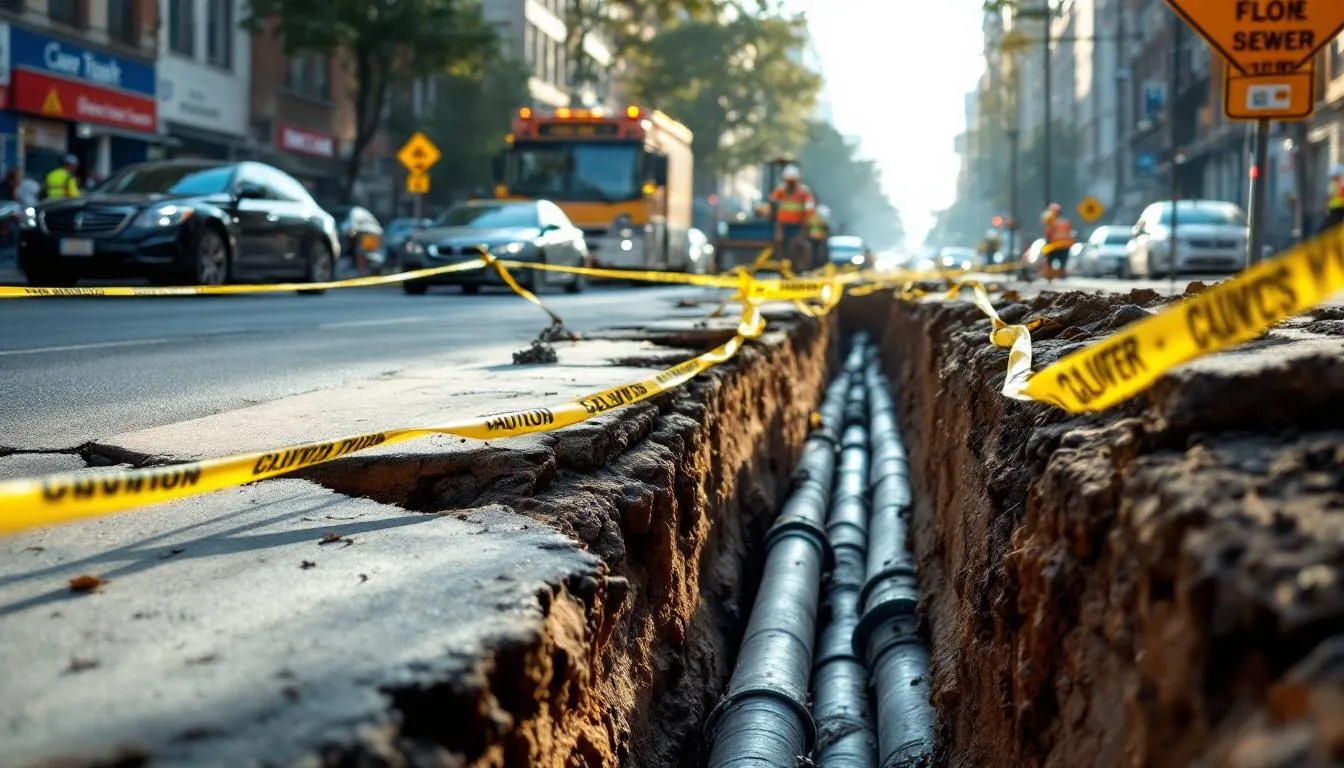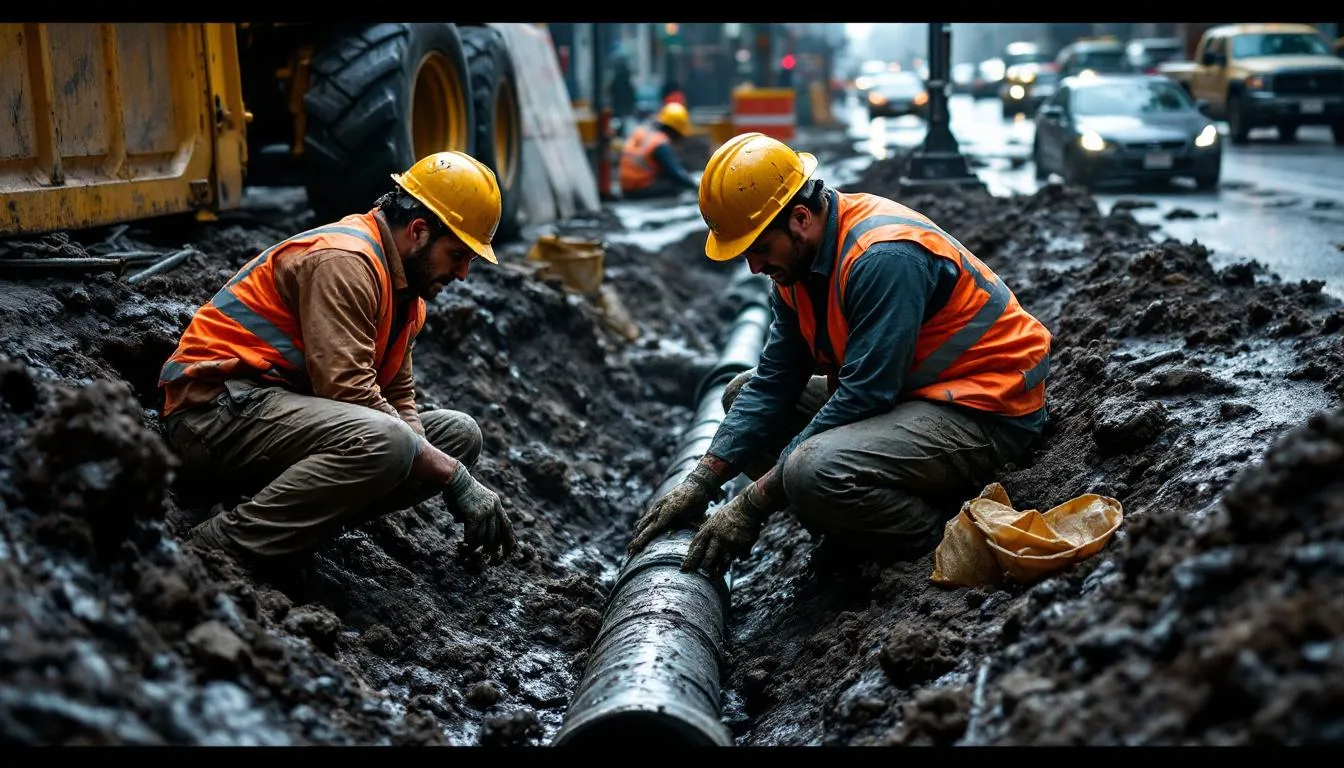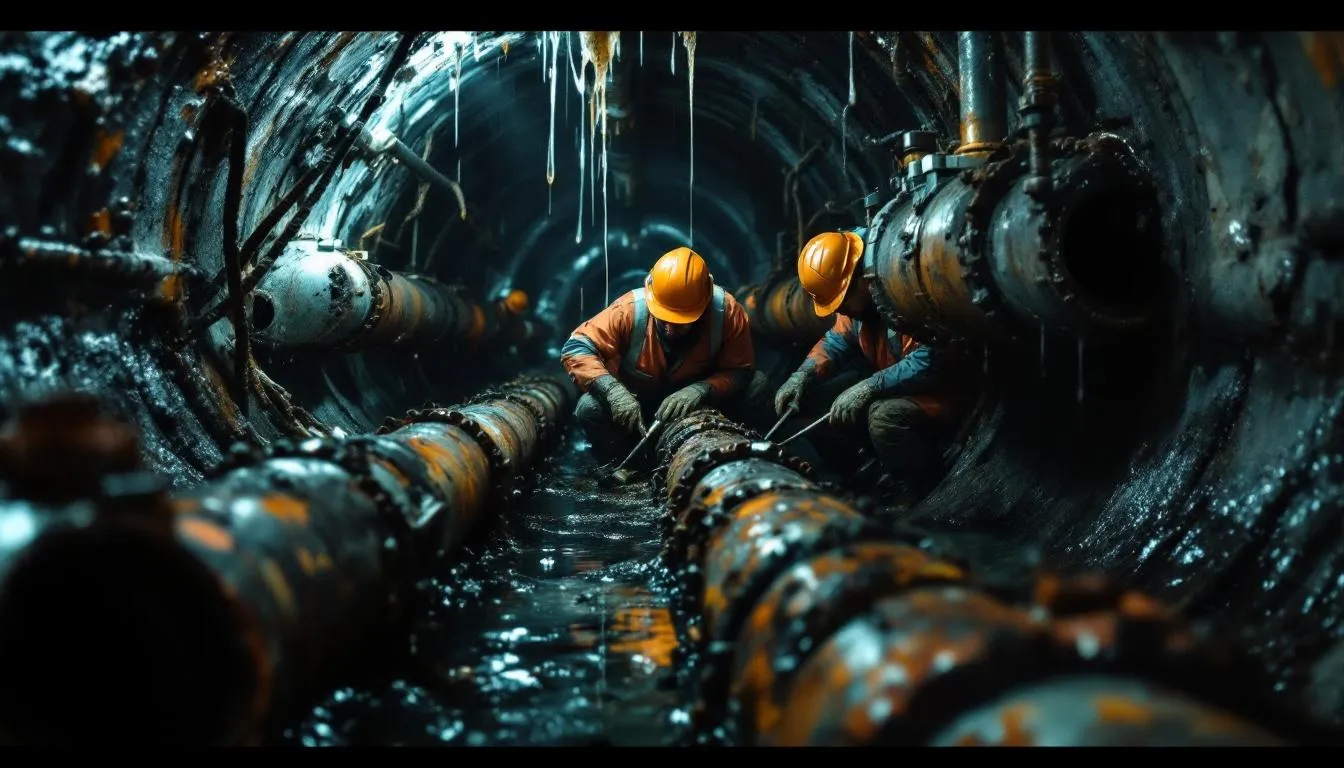Top Solutions for Sewer Line Repair and Replacement
Contents
- 1 Top Solutions for Sewer Line Repair and Replacement
- 1.1 Key Takeaways
- 1.2 Understanding Sewer Line Repair
- 1.3 Professional Methods for Sewer Line Repair
- 1.4 Signs You Need Sewer Line Repair
- 1.5 The Importance of Video Camera Inspections
- 1.6 Common Causes of Sewer Line Damage
- 1.7 Cost Considerations for Sewer Line Repair
- 1.8 Preventative Maintenance for Long-Lasting Sewer Lines
- 1.9 Choosing the Right Professional for Sewer Line Repairs
- 1.10 Financing Options for Sewer Line Repair
- 1.11 Summary
- 1.12 Frequently Asked Questions
- 1.12.1 What are the common signs that indicate I need sewer line repair?
- 1.12.2 How often should I get a video camera inspection for my sewer lines?
- 1.12.3 What are the main causes of sewer line damage?
- 1.12.4 Are there financing options available for sewer line repairs?
- 1.12.5 What is the difference between traditional excavation and trenchless sewer repair techniques?
Slow drains and sewage backups can indicate the need for sewer line repair. Learn the common causes, repair methods, and how to find the right professional to fix the issue.
Key Takeaways
Sewer line repairs can be approached through traditional excavation or trenchless methods, with trenchless techniques offering less invasive solutions.
Early detection of sewer line issues, such as slow drains and foul odors, is crucial to prevent costly repairs; regular video camera inspections can aid in identifying problems.
Cost factors for sewer line repair vary significantly based on damage severity, location, and repair method, with financing options available to help manage expenses.
Understanding Sewer Line Repair

Maintaining a healthy and functional plumbing system often involves sewer line repair. Slow or blocked drains may signal the need for sewer cleaning services. Routine drain cleaning often resolves these issues, but persistent problems may require repairing the sanitary sewer lines. A technician can outline the options and process for necessary repairs, helping you make an informed decision.
Root intrusion, ground shifting, and corrosion are common causes of sewer line damage. Cleaning the sewer line or conducting a drain line cleanup is advisable before planning any major repairs. Sometimes, a complete sewer line replacement isn’t necessary; exploring repair options can save time and money.
When quoted for interior sewer repair under your basement floor, consider seeking a second opinion to find accurate information and pricing.
Professional Methods for Sewer Line Repair
Professional sewer line repair methods are varied, broadly categorized into traditional and trenchless techniques. Specialized companies use advanced methods for effective sewer repair. Traditional excavation methods involve digging up the ground to access and repair damaged sewer lines.
Trenchless techniques like pipe bursting and cured-in-place pipe (CIPP) lining offer less invasive solutions. Hiring a professional ensures effective work with the proper trenchless pipe repair equipment.
Traditional Excavation
Traditional excavation involves cutting out the damaged sewer line section and splicing in a new PVC pipe. This process typically requires a trench at least 3 feet wide and 10 feet long. Replacing the entire sewer line is often recommended over repairing individual sections when multiple problem areas are identified. Contracts for sewer repairs usually specify a minimum replacement length of 10 feet.
In cases where the sewer line is relatively short, typically between 15-20 feet, it might be more cost-effective to replace the entire line rather than perform multiple repairs. Traditional excavation is often necessary when there are significant structural issues or multiple leaks in the sewer system.
Although disruptive to your property, traditional excavation offers a permanent solution to severe sewer problems.
Trenchless Sewer Repair Techniques
Trenchless repair techniques like cured-in-place pipe (CIPP) lining and pipe bursting revolutionize sewer line repair by minimizing ground disturbance while effectively addressing damage. Pipe lining involves creating a new pipe within the old one using a liner, making it an excellent option when the old pipe is structurally sound with minor issues. CIPP is a specific form of pipe lining that cures in place, forming a durable new pipe within the old one.
Pipe bursting is preferred for severely damaged lines, breaking the old pipe apart while simultaneously pulling a new one into place. This method is particularly useful for long pipe repair runs and when the original piping is too structurally unsound. The goal of pipe bursting is to minimize the impact on your property while efficiently installing new pipes.
Trenchless replacement preserves landscaping and reduces overall project costs. Various trenchless methods can address leaks without fully replacing the pipes, thus preserving more of the existing infrastructure.
Both pipe lining and pipe bursting offer effective, less invasive solutions to sewer line problems.
Signs You Need Sewer Line Repair

Early detection of sewer line damage can prevent costly repairs. Common indicators include:
Slow drains
Sewage backups
Foul odors Promptly addressing these warning signs can avert severe sewer issues. Fluctuating toilet bowl water levels may also signal venting issues or sewer line cracks.
Signs that may indicate a broken sewer line include:
Increased pest activity, like rodents
Wet lawn patches, especially near sewer cleanouts
Unusually green patches of grass, as leaking sewage acts as a fertilizer
Gurgling toilets and multiple clogged drains can be signs of blockages in the sewer line, causing trapped air to escape. Draining early recognition of these signs and seeking professional help can prevent extensive damage and keep your plumbing system functional.
The Importance of Video Camera Inspections
Video camera inspections are a game-changer in diagnosing sewer line issues. These inspections use a device providing a real-time video feed, allowing plumbers to identify the exact location and cause of blockages inside the sewer lines. This technology quickly illuminates the pipeline, exposing obstructions and damage, which aids in developing efficient repair solutions.
Regular inspections, ideally every 1-2 years or every few days, can detect minor issue before they become major problems. Video inspections reveal obstructions, cracks, and structural damage, offering a clear picture of the sewer system’s health. An inspection can help identify these issues early.
If traditional methods fail to clear a blockage, local video camera inspections can locate the specific problem, ensuring targeted and effective repairs.
Common Causes of Sewer Line Damage

Tree root intrusion is a common cause of sewer line damage. Roots infiltrate lines through small cracks, causing clogs and structural damage. Regular maintenance or barriers can prevent root intrusion.
Older sewer lines made of cast iron or clay deteriorate over time, leading to structural failures in the main sewer line. Ground movement from soil erosion or seismic activity can misalign sewer pipes and cause breaks.
Causes of damage to steel or cast iron pipes include:
Corrosion from mineral deposits, which leads to leaks
Extreme temperature changes that can freeze and expand pipes, causing cracks or bursts
Construction work near sewer lines that can inadvertently damage them if not properly marked and avoided
Cost Considerations for Sewer Line Repair

Sewer line repair and replacement costs vary significantly based on project complexity and work extent, typically ranging from $6,000 to $13,000. The location and depth of the damage also affect costs, as deeper or more inaccessible lines require specialized equipment.
The severity of the damage determines whether a simple repair or a full replacement is necessary. Replacement often doesn’t cost much more than repair when multiple problem spots exist or the line is short enough for cost-effectiveness. The type of pipe material affects repair expenses, with PVC generally being less costly than cast iron.
Homeowners should consider the following regarding sewer line repair and insurance:
Check if their insurance policy includes a sewer replacement rider, as insurance sometimes covers sewer line repair and replacement with a possible 90-day waiting period.
Use diagnostic camera inspections to get an accurate idea of the required repairs and costs.
Explore flexible payment schedules and financing options to help manage the repair costs.
Preventative Maintenance for Long-Lasting Sewer Lines

Preventative maintenance can prolong the lifespan of sewer lines, ultimately saving money on repairs. Routine descaling of vertical pipes enhances flow and reduces strain on the sewer system. Internal pipe coating seals small leaks and prevents future problems while being less disruptive and cost-effective.
Proper disposal of grease and non-degradable items is crucial to prevent sewer line clog. Annual cleaning sewer is recommended, especially with issues like root growth or clogs.
Proactive maintenance can lower repair cost compared to emergency repairs, which incur higher charges.
Choosing the Right Professional for Sewer Line Repairs
It’s essential to choose the right professional for sewer line repairs to ensure the job is done correctly. Key factors to consider include:
Verifying licensing and insurance to ensure they can legally perform the services.
Effective communication.
Good customer service, which are key attributes of a reputable sewer repair company.
A trustworthy company should emphasize:
Communication
Transparency
Honesty
Integrity
Customer service
These qualities help build trust with customers. If sewer line damage is suspected, contact a professional plumber if help is needed and needs are addressed immediately. Professionals can provide the expertise required for effective solutions.
Financing Options for Sewer Line Repair
Financing options for sewer line repairs can make the process more manageable. These options include:
Home equity loans or lines of credit for larger plumbing projects.
Personal loans specifically for plumbing repairs, allowing homeowners to compare offers from multiple lenders.
In urgent plumbing situations, residential homeowners can often get pre-qualified for financing quickly, sometimes with same-day funding. Using credit cards for plumbing repairs is common; however, personal loans may offer lower interest rates and fixed repayment terms, working to provide better options for homeowners.
If financing options are not available, homeowners may negotiate payment plans directly with their plumbers for their home’s needs.
Summary
In summary, addressing sewer line issues promptly and effectively is crucial for maintaining a healthy plumbing system. From understanding the signs of damage to exploring various repair methods and financing options, homeowners have a range of solutions to consider. Regular maintenance and choosing the right professional can ensure long-lasting sewer lines and prevent costly repairs in the future. By staying proactive and informed, you can safeguard your home against the challenges of sewer line problems.
Frequently Asked Questions
What are the common signs that indicate I need sewer line repair?
If you notice slow drains, sewer backups, foul odors, or unusually green patches in your lawn, it’s a strong indication that you may need sewer line repair. Pay attention to these signs to address potential issues promptly.
How often should I get a video camera inspection for my sewer lines?
It’s advisable to get a video camera inspection for your sewer lines every 1-2 years to catch minor issues early and prevent more significant problems. Regular maintenance will help ensure the longevity and efficiency of your sewer system.
What are the main causes of sewer line damage?
Sewer line damage primarily results from tree root intrusion, ground movement, corrosion, outdated materials, extreme temperature variations, and nearby construction activities. Taking preventive measures against these factors is essential for maintaining your sewer system’s integrity.
Are there financing options available for sewer line repairs?
Yes, there are several financing options for sewer line repairs, such as home equity loans, personal loans, and payment plans offered by plumbing companies in partnership with finance firms. Consider discussing these options directly with your plumber for tailored solutions.
What is the difference between traditional excavation and trenchless sewer repair techniques?
Trenchless sewer repair techniques are less invasive than traditional excavation, as they minimize ground disturbance through methods like CIPP lining and pipe bursting. This results in a more efficient repair process with reduced disruption to the surrounding area.
